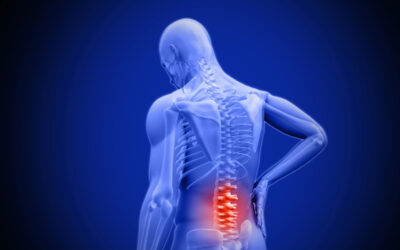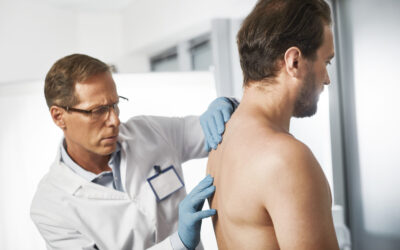
Back pain is an extremely common medical problem that most people will experience at some point in their lives. Over 80% of adults will have low back pain at least once. Understanding the various causes and risk factors for back pain is crucial to getting proper treatment and preventing future episodes. This guide will provide an overview of the anatomy of the back, explain the main causes of back pain, and describe when you should see a doctor.
Anatomy of the Back
The human spine is comprised of 33 vertebrae interlinked together to form the central support structure of the back. These 33 vertebrae can be divided into regions based on their location:
The Cervical Spine
The cervical spine consists of the first 7 vertebrae beginning at the base of the skull. These vertebrae are designated C1 through C7, with C1 being the topmost vertebra that connects to the skull.
The cervical spine enables mobility of the neck and supports the weight of the head. Each cervical vertebra has a hole through which the spinal cord passes, along with a transverse process on either side allowing attachment of muscles and ligaments.
Between each cervical vertebra is an intervertebral disc that provides cushioning. Herniation of these discs is a common cause of neck and arm pain.
The Thoracic Spine
The next region is the thoracic spine, containing vertebrae T1 through T12. These 12 vertebrae connect to the ribs to form the central part of the ribcage.
The thoracic vertebrae are larger in size compared to the cervical and lumbar regions. They have longer spinous processes that protrude posteriorly. These processes can be felt as the bony bumps in the center of your upper and mid back.
The thoracic spine bears most of the weight from the upper body and provides attachment points for the muscles involved in breathing.
The Lumbar Spine
The lowest section of the spinal column is the lumbar spine, consisting of vertebrae L1 through L5. These largest, thickest vertebrae bear the majority of the body’s weight.
The lumbar region contains the natural inward curve of the spine called lumbar lordosis. This region experiences significant rotational and bending forces when twisting or lifting. Injuries to the lumbar discs are the most common source of lower back pain.
Below the lumbar spine lies the sacrum and coccyx that make up the remainder of the vertebral column. The intricate interconnectivity of all these vertebral elements is what provides structural support and flexibility to the back.
Sacrum and Coccyx
The sacrum is a triangular bone at the bottom of your spine. Below this is the coccyx or “tailbone.”
In between each vertebra are discs that act as cushions or shock absorbers. Your spine also contains various muscles, tendons, and ligaments that hold everything in place and allow movement.
Core muscles in your abdomen and back play a key role in stabilizing your spine when bending and lifting. Weak core muscles can lead to increased strain on the structures in your back.
Main Causes of Back Pain
There are several potential causes of back pain, often involving some type of strain, injury, or underlying condition.
Mechanical/Structural Problems
Issues with the bones, discs, muscles, ligaments, or tendons in your back are common sources of pain.
- Sprains: An injury to the ligaments that connect vertebrae. Twisting or lifting incorrectly can cause a sprain.
- Strains: This refers to an injury to the muscles or tendons. Overstretching or tearing of muscle fibers leads to inflammation and pain.
- Degenerative disc disease: As you age, the discs between vertebrae break down, losing flexibility and shock absorption. This can cause back stiffness and achiness.
- Herniated discs: Also called ruptured discs, this is when a disc abnormally bulges and presses on nearby nerves. It often occurs in the lumbar spine. Symptoms include sciatica leg pain.
Inflammatory Conditions
Certain types of inflammatory arthritis can affect the spine and lead to back pain.
- Ankylosing spondylitis: This chronic condition causes inflammation in the spinal joints, often progressing to fusion of the vertebrae. It typically starts in the lower back.
Other Medical Conditions
Some other health problems that are not directly spine-related can sometimes manifest with back pain.
Osteoporosis: When this condition weakens your bones, fractures in the vertebrae can occur, resulting in acute back pain. Osteoporosis is more common in older women.
Kidney stones: As stones pass through the urinary tract, they can cause severe pain that radiates from the back around to the abdomen.
No Identifiable Cause
For many instances of back pain, there is no clear mechanical cause or underlying condition identified.
Myofascial pain syndrome: This refers to chronic pain and tightness in the muscles of the back due to injury or abnormal nerve signals. It can occur without a specific spinal abnormality.
Risk Factors for Back Pain
Certain factors can increase your likelihood of developing back pain. Being aware of these risks allows you to take preventative steps.
- Lack of exercise: Weak back and abdominal muscles increase strain on the spine. Inactivity and poor fitness level make back pain more likely.
- Being overweight: Excess weight, especially around the abdomen, puts added stress on the muscles supporting the back. This extra load raises risk of pain.
- Older age: Degenerative changes to the spine are more common with aging. Back pain prevalence increases starting around age 45.
- Stress: Chronic stress and anxiety can manifest with back pain. Stress also causes muscle tension.
When to See a Doctor
In most cases, back pain improves with rest, heat/ice application, medication, and gentle stretches. However, you should make an appointment with your doctor if you have any of the following:
- Numbness or tingling in the legs
- Loss of bowel or bladder control
- Unexplained weight loss along with back pain
- Back pain after a significant injury or fall
- Fever occurring with back pain
- Pain not improving after 4-6 weeks of self-care
Getting evaluated allows your doctor to check for serious causes and guide appropriate treatment. Most back pain resolves on its own, but getting help sooner aids recovery.
Conclusion
Back pain has many potential causes, from sprains and strains to degenerative changes and underlying conditions. Protect your back through exercise, weight management, proper lifting mechanics, and managing stress. See your doctor if warning signs appear, but otherwise gentle movement and over-the-counter medication can help ease most back pain episodes. Understanding the origins of your particular back pain leads to faster relief.
Written by Dr. Tony Mork
Orthopedic Spine Surgeon
I’m Dr. Tony Mork, MD, a Minimally Invasive Orthopedic Spine Surgery Specialist in Newport Beach, California. With over 40 years of experience, I’m dedicated to providing information for all topics that involve neck and back pain.
November 8, 2023
Contact a Spine Specialist Near You!
Related Articles
Lower Back Pain | An Overview
Lower back pain is an exceedingly common affliction that affects up to 80% of adults at some point in their lives. Understanding the underlying causes of lower back pain is key to finding the appropriate treatment and relief. Anatomy of the Lower Back The lower back,...
Degenerative Disc Disease | Causes and Risk Factors
Degenerative disc disease describes age-related wear and tear to the rubbery spinal discs cushioning the vertebrae that can lead to chronic back or neck pain. While partly genetic, there are also lifestyle factors and injuries that accelerate disc degeneration over...
Upper (Thoracic) Back Pain | What is Causing My Pain?
Upper back pain is a surprisingly common affliction, affecting up to one-quarter of the adult population at some point. While not as prevalent as lower back pain, discomfort in the thoracic region still accounts for a substantial slice of musculoskeletal complaints...



